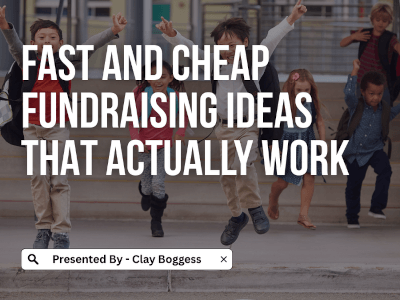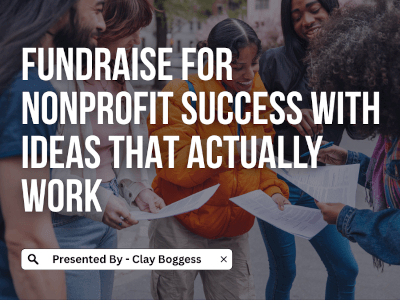
Summary: This blog explores the powerful impact of incentives on school fundraising efforts. It explores how different incentives can significantly enhance participation and financial contributions from students, parents, and teachers.
I'm excited to discuss a topic that touches many of our lives today: school fundraising. Whether you're a student trying to support your class trip, a parent helping out with the PTA, or a teacher organizing events to fund new resources, you've likely encountered the world of fundraising. But have you ever stopped to think about what drives people to reach into their pockets and contribute? Well, incentives play a huge role in this.
![]()
Why Incentives Matter in Fundraising
Motivation Behind Incentives
At its core, they are using incentives in fundraising taps into a fundamental aspect of human behavior: motivation. Incentives, tangible rewards, recognition, or personal satisfaction encourage people to act like they might not otherwise.
For instance, when students know they could earn a prize or gain a privilege for contributing to a fundraiser, their interest and participation can significantly increase because incentives provide an apparent reason to change behavior—linking effort directly to a rewarding outcome.
Types of Incentives
Incentives in school fundraising come in various forms and cater to different audiences:
Recognition: Public acknowledgment can be a powerful incentive, as simple as announcing contributors’ names during school assemblies or featuring them in the newsletter.
Prizes: Use tangible rewards such as gadgets, books, or special event tickets. These are especially popular among students.
Experiences: Unique experiences like a lunch with the principal, homework day, or a class outing are great ideas. Such rewards create lasting memories and are highly valued.
Each type of incentive appeals to different motivational triggers and can be tailored to fit the specific demographic of your school community.
Psychological Impact
The psychological impact of incentives is particularly significant among students. Behavioral psychology suggests that positive reinforcement, like the incentives used in fundraising, can strengthen desired behaviors.
For students, receiving a reward for a fundraising contribution can validate their effort and spur further participation. It also builds a habit loop, reinforcing the behavior as they associate fundraising with positive outcomes.
Incentives boost the immediate success of fundraising campaigns and foster a longer-term engagement and sense of belonging among participants. They are about the rewards and the message—that everyone’s contribution is valued and meaningful.
![]()
Incentive Ideas That Spark Enthusiasm
Regarding school fundraising, the right incentives can make all the difference. They enhance participation rates and foster a spirit of community and excitement.
Creative Incentives for Students
Students are often motivated by immediate and tangible rewards. Therefore, selecting incentives that resonate with their interests and daily lives can significantly boost their enthusiasm to participate. Here are a few ideas:
- Tech Gadgets: Items like earbuds, smartphone accessories, or even a new tablet for a raffle can create a buzz. Many students desire These high-value items but might need help to purchase them.
- School Privileges: Privileges such as a pass to skip the lunch line, a homework pass, or even a coveted parking spot can be very appealing. These rewards offer students a sense of prestige and convenience in their school environment.
- Exclusive Experiences: Organize events where students can participate in exclusive activities, such as a pizza party with a teacher, a behind-the-scenes tour of a local business, or a day as a principal. These experiences are memorable and often the talk of the school.
Incentives for Parents and Teachers
While students may be motivated by gadgets and privileges, adults often look for different rewards. Here are some incentive ideas that can encourage greater participation from parents and teachers:
- Tax Benefits: If your organization qualifies, remind participants that their contributions can be tax-deductible. Providing easy-to-follow guides for claiming these benefits can add more motivation.
- Community Recognition: Adults appreciate recognition for their efforts. Consider using newsletters, local newspapers, and school board meetings to highlight top contributors. Plaques, student thank-you notes, and public acknowledgments are great ways to give adults the recognition they deserve.
- Professional Development: For teachers, offering incentives that include professional development opportunities, such as paid attendance at conferences or workshops, can be very motivating. It’s a way to contribute to their personal and professional growth while benefiting the school.
Balancing Cost and Appeal
While the incentives listed can be highly effective, balancing the cost with the appeal is crucial to ensure your fundraising efforts remain profitable. Here are some tips on how to strike that balance:
Leverage Local Businesses: Partner with local businesses to donate items or services as incentives that reduce costs and strengthen community ties. Businesses are often willing to help, especially if recognized as sponsors in school communications and events.
Scale to Participation: Offer tiered rewards to encourage more significant contributions. For instance, small donations could earn a thank-you note or a mention in a newsletter. At the same time, more significant contributions could result in more substantial rewards like tech gadgets or professional development courses.
Evaluate and Adapt: After each event, evaluate the effectiveness of your incentives. Which were most popular? Did they increase participation as expected? Use this data to adapt future incentives to maximize participation and fundraising efficiency.
You can create a more engaging and successful fundraising campaign by carefully selecting and implementing these incentive ideas. The key is to choose rewards that excite the participants and align with your school's fundraising goals and budget constraints.
Whether through high-tech gadgets for students or recognition and development opportunities for adults, well-chosen incentives can transform the fundraising experience from obligatory to eagerly anticipated.
![]()
Implementing Incentives in Your Next Fundraiser
Regarding school fundraising, the devil is truly in the details. Each step can significantly influence your campaign's success, from choosing the right incentives to planning how to pitch them to your community.
Planning and Budgeting
First, your incentive plan needs a solid framework that aligns with your budget. Here’s how you can lay the groundwork:
1. Set Clear Objectives: Before you start picking out incentives, define what success looks like for your fundraiser. Are you aiming to increase participation by 50%? Or double the funds raised from last year? Clear goals will help you determine the scale and type of incentives needed.
2. Choose Your Incentives Wisely: Select incentives that resonate with your audience but don't break the bank. Small but appealing rewards, like a no-uniform day, can be incredibly effective for students. For parents, consider options like reserved parking spaces for event days—benefits that offer convenience but little to no cost to implement.
3. Create a Budget: Once you've identified your incentives, itemize the associated costs. Don’t forget to account for all aspects, including purchasing costs, distribution logistics, and any third-party services you might need. This budget will be your blueprint for managing expenses throughout the campaign.
4. Funding Your Incentives Explore ways to fund these incentives that don't solely rely on the fundraiser's primary income. Sponsorships from local businesses, for instance, can cover some or all of the costs associated with your incentives.
Logistics and Promotion
Getting the word out effectively is as important as the incentives themselves. Here’s how to ensure your chosen incentives capture and keep attention:
1. Early Promotion: Start promoting your incentives well before fundraising begins. Use newsletters, school meetings, and social media to tease what’s coming. Excitement builds anticipation, which can lead to higher initial participation.
2. Transparent Communication: Determine how participants can qualify for incentives. Detailed information should be easily accessible through multiple channels—consider a dedicated section on your school’s website, social media posts, and newsletter reminders.
Engage Community Influencers: Identify and engage students, parents, and well-connected teachers within your community. Equip them with the details they need to help spread the word effectively.
Visual Promotions: People respond to visuals, so be sure and use attractive posters around the school, eye-catching flyers to send home, and vibrant graphics online. Each piece should clearly articulate the 'what, when, and how' of your incentives.
Measuring Success
After the fundraiser wraps up, assessing how your incentives impact the campaign is crucial. Here’s a streamlined approach to evaluating their effectiveness:
- Survey Participants: Gather feedback through surveys or informal conversations with participants. Ask direct questions about the incentives, such as which ones appeal most to them and why.
- Analyze Participation Levels: Look at the numbers. Did participation increase compared to previous fundraisers? Were there more new participants? This data can help you see which incentives worked and which didn’t.
- Review Financial Goals: Evaluate whether the incentives helped meet or exceed your financial goals. It's essential to consider gross revenue and net profit, factoring in the cost of the incentives.
- Plan for Improvement: Use the insights gained to refine your approach for the next fundraiser. Which incentives should you keep, modify, or drop altogether?
Follow these detailed steps in planning, promoting, and evaluating your incentives to meet and exceed your fundraising goals. Effective incentive strategies create a win-win situation where participants are motivated to contribute more actively, and the school benefits from heightened engagement and increased funds.
Remember, every fundraiser is a learning opportunity to perfect your approach for the next time!
The successful strategies discussed show that the type of incentive matters greatly, whether it’s recognition at an assembly, a coveted gadget, or a group outing. It’s about understanding what excites and motivates your community and using that knowledge to fuel participation.
Balancing the appeal of these rewards with the practical aspects of budgeting and planning ensures that fundraisers are both practical and sustainable.
Reflecting on these insights, I see a bright future for school fundraising initiatives that adopt innovative and thoughtful incentive plans. Implementing these ideas could revolutionize how fundraising goals are met and even surpassed, making each campaign more successful than the last.
The key lies in continuous experimentation and adaptation, ensuring that every fundraiser is as unique as the community it supports.
If you want more innovative fundraising solutions and personalized assistance, I encourage you to visit Big Fundraising Ideas. We have a wealth of resources and expert advice to help you take your fundraising to the next level.
Lastly, if you found this discussion enlightening, please share this blog with others who might benefit. Whether they are fellow educators, parents, or even students, spreading the word helps cultivate a community of proactive, engaged, and inspired fundraisers. Let's make school fundraising more effective and enjoyable for everyone involved!
Frequently Asked Questions (FAQs)
1. What are the most effective incentives for school fundraising?
The effectiveness of incentives can vary based on the demographic (students, parents, teachers). Still, generally, popular incentives include special events, privileges for students (like a no-homework day), recognition awards for parents, and grants or bonuses for teachers. Combining these with tangible rewards like gadgets or gift certificates often yields the best results.
2. How can schools implement incentives without significantly increasing the fundraising budget?
Schools can partner with local businesses to sponsor or donate goods and services they can use as incentives. Additionally, leveraging low-cost but highly valued incentives, such as privileges or unique experiences (like lunch with the principal), can be very effective without adding financial strain.
3. Are incentives necessary for successful school fundraising?
While unnecessary, incentives can significantly boost participation and engagement, leading to higher fundraising success. They motivate students and adults alike, especially when the rewards align with the participants' interests.
4. What are some creative incentive ideas for engaging both parents and students?
Combining activities that involve both students and parents can be highly effective. For example, consider a family fun day event, where participation in fundraising earns free tickets, or a DIY project kit for a home that students and parents can build together. These activities not only serve as incentives but also help build community spirit.
5. How can we measure the impact of incentives on school fundraising?
Schools can track participation rates and total funds raised and compare these metrics to previous fundraisers without incentives. Surveys and feedback forms can also be valuable for gathering qualitative data on participant motivation and satisfaction with the incentives offered.
Author Bio
Clay Boggess has been designing fundraising programs for schools and various nonprofit organizations throughout the US since 1999. He's helped administrators, teachers, and outside support entities such as PTAs and PTOs raise millions of dollars. Clay is an owner and partner at Big Fundraising Ideas.



